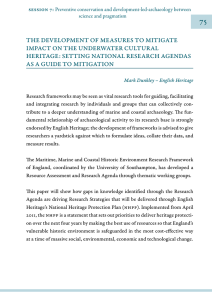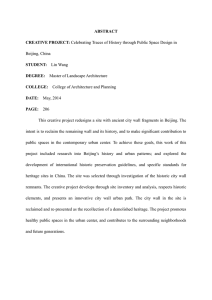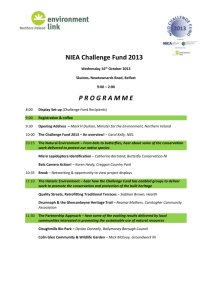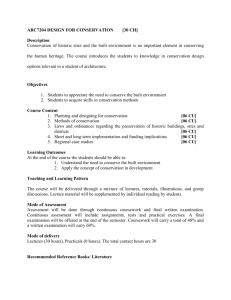CHAPTER 1 INTRODUCTION 1
advertisement
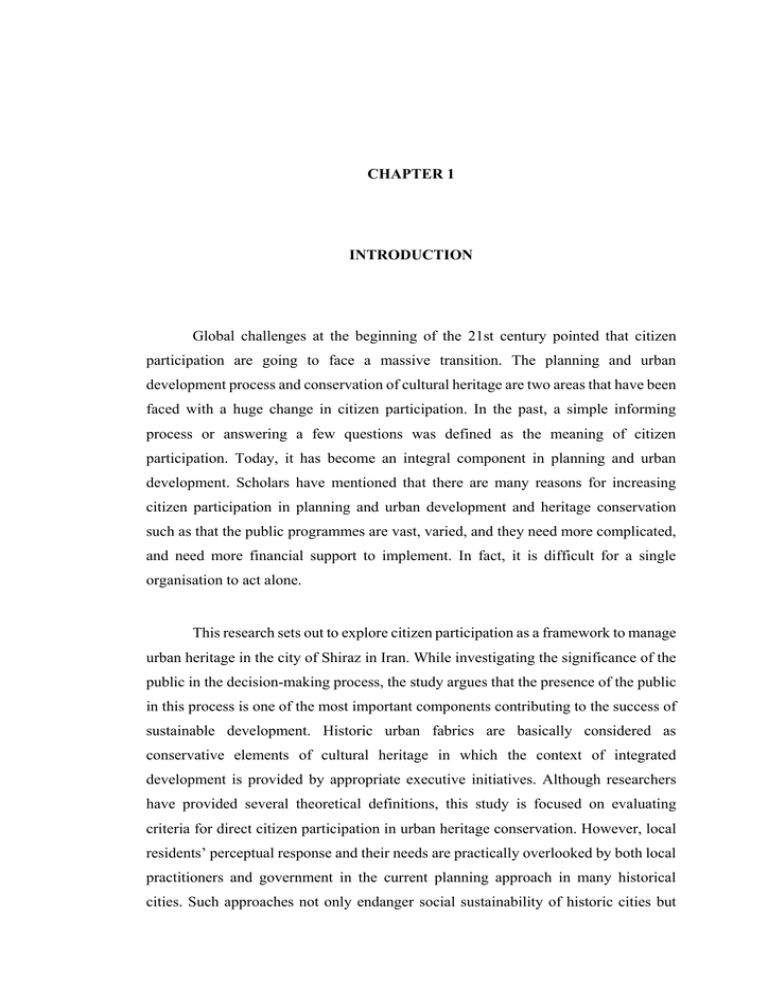
CHAPTER 1 1 INTRODUCTION Global challenges at the beginning of the 21st century pointed that citizen participation are going to face a massive transition. The planning and urban development process and conservation of cultural heritage are two areas that have been faced with a huge change in citizen participation. In the past, a simple informing process or answering a few questions was defined as the meaning of citizen participation. Today, it has become an integral component in planning and urban development. Scholars have mentioned that there are many reasons for increasing citizen participation in planning and urban development and heritage conservation such as that the public programmes are vast, varied, and they need more complicated, and need more financial support to implement. In fact, it is difficult for a single organisation to act alone. This research sets out to explore citizen participation as a framework to manage urban heritage in the city of Shiraz in Iran. While investigating the significance of the public in the decision-making process, the study argues that the presence of the public in this process is one of the most important components contributing to the success of sustainable development. Historic urban fabrics are basically considered as conservative elements of cultural heritage in which the context of integrated development is provided by appropriate executive initiatives. Although researchers have provided several theoretical definitions, this study is focused on evaluating criteria for direct citizen participation in urban heritage conservation. However, local residents’ perceptual response and their needs are practically overlooked by both local practitioners and government in the current planning approach in many historical cities. Such approaches not only endanger social sustainability of historic cities but 2 also lead to loss of historic and cultural heritage (Sirisrisak, 2009; E. H. Yung & Chan, 2011). This study implies that the old and historic areas of cities are a significant part of historic cities; they should be conserved for future generations. Cultural-historic areas the city of Shiraz in Iran have been identified as an appropriate area to be examined as a case study. The literature in urban heritage conservation and urban planning suggests that the historic urban fabric in most historic cities such as Shiraz in developing countries currently faces similar issues. On the one hand, these cities are experiencing rapid population growth, high development pressure, increasing numbers of historic districts, and destruction of cultural heritage (Ashworth & Larkham, 1994; Kong & Yeoh, 1994; Steinberg, 1996). On the other hand, researchers don’t pay attention to the importance of citizen participation as the most significant factor in solving their issues in the decision-making process (Abdi & Namin, 2008; Kong & Yeoh, 1994; H. Mohammadi, 2010; Steinberg, 1996). Moreover, because of the significance of Shiraz more than 4,000 years old (Movahed, 2012), this historic city can be an appropriate case in developing countries to investigate the role of the public in the process of urban heritage conservation. In this study, the meaning of citizen participation is taken from T. Webler and Tuler (2001, p. 30) as a “variety of procedures for enabling diverse members of the public to be active participants in deliberations about preferred policy options, and in some cases decision-making.” With this approach, citizen participation can be evaluated based on two criteria, including the process and the outcome. It should be noted that these criteria were used to evaluate citizen participation in many studies in the last two decades (Beierle, 1999; Beierle & Cayford, 2002; Edwards, Hindmarsh, Mercer, Bond, & Rowland, 2008; Mannarini & Talò, 2013; Rowe & Frewer, 2000, 2004). However, to this end, this study has first determined the issues, deficiencies, and potential of citizen participation in planning and decision-making processes in Urban Heritage Conservation (UHC) programmes in Iran; and then evaluated the level of current public participation practice in the decision-making process in the old and historic city of Shiraz. However, the study seeks to determine an appropriate basis for 3 Shiraz’s historic conservation area management that will be used as a new guideline for social sustainability in the city. 1.1 Background of the Study According to UNESCO’s definition, cultural heritage includes monuments, groups of buildings, and sites that have historical value; in other words, all tangible heritage, which includes natural and cultural sites, and even all intangible heritages, which consists of living dimensions of heritage and all aspects of the physical and spiritual relationships between the human community and their local environment (Lowenthal, 1999; Tweed et al, 2007; UNESCO, 1972). It is important to know that urban heritage is also an embodiment of values of traditional urban cultures for the memory of mankind (ICOMOS, 1987). Nowadays, many such assets are being threatened, physically degraded, and damaged at an alarming rate around the world as a consequence of a lack of consideration for their conservation by stakeholders and practitioners and of course governments (Tweed et al, 2007). These significant issues are nowhere more complex than in developing countries and regions with limited financial resources available (Yung et al, 2011). Although researchers and practitioners have pointed out that there are many challenges regarding the issue of urban heritage conservation such as depopulation of inner cities, development pressure, insufficient legislation and poor enforcement, poor design of new townships, changing lifestyle and consumption patterns, tourist expectations, public awareness lack of citizen participation in the last 20 years has increasingly become a significant challenge throughout the world ( Cohen, 1999; ICOMOS, 1999, 2002; Engelhardt, 2002; Imon, 2006;Lane, 2005; Sirisrisak, 2009;Tweed et al., 2007; Yung et al., 2011). It is of the same opinion that one of the key elements in the success of the social sustainability process is citizen participation, which has been neglected or has been only slightly considered in the planning process of urban heritage conservation (Sirisrisak, 2009; Tweed et al., 2007; Yung et al., 2011). However, the weight of evidence over the years has suggested that researchers have studied several approaches to show the role of citizen participation in these processes, a majority of which efficiently presented solve issues in developed countries and occur less frequently in 4 developing countries (see, for example, Chung, 2003; Evans, 2002; Moser, 1989; Smith et al, 2003; Tweed et al, 2007; Yung et al., 2011). Although Shiraz the fifth largest city in Iran, it is very popular as a cultural and historic city among all Iranian cities and even among cities in all countries of the Persian Gulf region. If someone ask any Iranian or any Persian Gulf nationalities about their historic attractions, they know where Shiraz is (Movahed, 2012). There is no similar tangible and intangible heritage like Zandieh’s historic monuments, such as Arg-e Karim Khani, the Persian Gardens, the historic bazaar, the landscape axes of the city, Shirazi accent, etc. especially in the cultural-historic area of the city. In addition to the monuments, there is unique handicraft production such as Khatam objects, which are not elsewhere. Some of these heritage sites, such as the Persian gardens have been submitted to the World Heritage Site List, and some others, such as the old bazaar, and the Arg-e Karim Khani monument are candidates for the list (See Figure 1.1). However, this tangible and intangible heritage is disappearing and decaying in the form of destruction of monuments and fading customs and traditions, though it has carried much of the historic value of Iran as possible. Both tangible and intangible heritage are now threatened by extensive destructions in the old and historic area, and ultimately, it causes to disappear Shiraz’s unique identity. It is acknowledged by researchers that Shiraz’s urban history will not be complete without these unique values. However, these cultural heritage sites are not being conserved neither by the local government nor relevant policy makers. 5 Vakil Bazaar Arg-e Karim Khani Eram Garden Figure 1.1 Khatam Objects Some of Valuable Tangible Heritage in the Cultural-historic Area of Shiraz As the main driving force of urban heritage conservation plans, citizen participation should be considered to generate fresh ideas where people are able to participate directly in conserving their heritage. This understanding has been brought up by participatory approaches, which are oriented to a bottom-up approach that involves extensive discussions with the target community. Today’s principles of participatory approaches can regularly succeed to encourage people to become involved in the decision-making process, while these approaches in different fields among UHC initiatives needs more evaluation and study of their effective criteria and circumstances. 1.2 Problem Statement The community is a social unit of urban areas which consists of people with a strong and durable ties (Henning & Lieberg, 1996). Residents of the community handle 6 conserving tangible and intangible heritage. While, Washington Charter (1987) confirmed it is impossible without considering and grabbing citizen participation (CP) for the success of the conservation programmes (ICOMOS, 1987). It is now considered that CP creates the boundaries within which the community will encourage, support or at least accept for conserving their heritage. However, it is questionable how to evaluate participation of the community (Roberts & Stalans, 1997). While researcher is sympathetic to this view that CP is a highly context-driven, social and political process. In this case study, there are several arguments for evaluating CP. Cultural-historic area of Shiraz is a distinctive cultural-historic community in Iran (Consulting Engineers Company, 2005). It represents a glorious past from historic periods, Particularly Zandieh Period. Residents of the community make some specialized handmade products such as inlay (Khatam products), pottery, Gabbeh Carpet, Scrimshaw, Miniatures products, and so on. They have, on one hand, a significant value in reflecting community identity, and on the other hand, have an especial status in the economy of the residents (Limbert, 2004). Today’s, they are under certain condition. They have a lack of appropriate housing, urban services and health care facilities which leads them to leave their traditional works (Movahed, 2012). That means the community is losing its gorgeous cultural and traditional values which represent Shirazi culture for many decades (Hanachi, 2010; Movahed, 2008). Because of the tremendous loss of cultural heritage materials, the municipality of Shiraz established some people-oriented institutions in 2009. They have named Modernisation and Facilitator Services Bureau (MFSB) which consist of residents who are familiar with residents’ needs and have experiences in urban affairs (Shiraz, 2013). They handle determining residents’ issues and authorized to resolve the issues through urban management. They, also, handle encouraging people for participation in the decision-making process. From 2009, these MFSB agencies claimed that many residents could participate in the planning process for conserving cultural heritage in the area (Qaani MFSB, 2012). They believed that they could meet the following objectives for protecting their traditional urban culture in the area: i. To provide database of people information and their needs and issues, 7 ii. To recognize the deferent aspects of neighborhoods in the Cultural-historic iii. area, iv. To develop the vision of each neighborhood, v. To provide an action plan, vi. To do educational programs, vii. Participation and empowerment, viii. To provide rehabilitation plan in the area, ix. Documentation, x. To execute interagency agreements, xi. To raise awareness, xii. Institution-building, xiii. Renovation by residents, xiv. To define, monitor and control in the projects of development driver in the xv. area, Mohammadi et.al (2013) investigated some measures of Iranian’s local government and municipalities in Iran (Mohammadi, T, & Mozafar, 2013). They focused on those measures that were in conjunction with the intervention in urban historic districts. They found that the measures had not wildly been in the areas. They have not considered the all socio-economic, physical and environmental aspects. For example, some projects that have been carried out within urban historic districts such as Bin al-haramin street project, modernisation projects by accumulating lots from small to large scale and etc. could not improve the circumstances of historic districts in Shiraz (Hanachi, 2010). Indeed, studies have shown that the approaches of these projects have been as the Top-down and non-participation approaches. These approaches led to meet the conservation plans with less than 45 percent success (Movahed, 2012). From 2009, local government established MFSB organisations to fill out the existing gap between local government and municipalities, and people (Mohammadi et al., 2013). These organisations have established to provide a proper platform for encouraging people in participation in urban planning and conservation. However, a Cultural-historic area of Shiraz is unique Zandiyeh’s historic ensemble in Iran. It is losing the unique historic values by an increase in looting considerable damage to the cultural heritage (Andalib, 2012; Hanachi, 2010; Jahanshahi, 2009; Mohammadi et al., 2013; Movahed, 2012). 8 1.3 Objectives of the Study This research aims to evaluate citizen participation (CP) as a framework to manage urban heritage in the city of Shiraz, Iran. To this end, it determines the most critical issues and deficiencies of citizen participation in urban conservation planning initiatives in the city. It also evaluates criteria of participation in a certain NGO, called Modernisation and Facilitator Services Bureau (MFSB). It is where the old areas’ residents attending the meeting for conserving cultural heritage in the area. Therefore, the following objectives have been selected to achieve the aim: i. To determine issues and deficiencies of citizen participation in the planning and urban conservation programmes in Shiraz, Iran, ii. To determine a proper strategic planning approach for urban planning and conservation programmes in Shiraz, Iran, iii. To evaluate criteria of participation in current citizen participation practices in the decision-making process in urban heritage conservation in Shiraz, Iran. iv. To determine a set of guidelines for integrated UHC management associated with citizen participation in the scope of research. 1.4 Significance of the Study Prior to the 1960s, governments were executors in the urban planning process, particularly in its economic and management aspects, so top-down approaches were the most common model in the decision-making process ( Mohammadi, 2010). In the 1960s, participatory management impacted this situation and led to the spread of participatory and democratic models. After the 1960s, concepts such as sustainable development, democracy and human rights took hold in the concepts of urban 9 planning. Now, different theories have been presented to show the role of people in the decision-making process (Yung et al, 2011). Critical issues of urban heritage conservation have begun in the 21st century and are rapidly moving toward a revolution in duties, aims, and methods. Most practical and theoretical efforts that have been performed in these areas have been based on a combination of methods and planning principles such as democracy, participation of public and private sectors, supporting poor people, and most importantly, the presence of people in the conservation of cultural heritage (Mohammadi, 2010). However, a lack of understanding of how to integrate urban conservation with urban development processes and its relationship to citizen participation remains a major obstacle to achieve this objective. This study, by investigating current citizen participation practices in the decision-making process in urban heritage conservation and its evaluation within the framework of an urban conservation strategy for Old Shiraz, therefore, will serve two main purposes: 1.4.1 Contribution to Theoretical Framework The study examines the certain criteria and tests measurable indicators for evaluating citizen participation and their role in reflecting decision-making in urban heritage conservation (UHC) initiatives. In this respect, it can provide a theoretical framework to determine similar issues with citizen participation in the urban contexts of old and historic areas of cities, particularly in cities of developing countries. We are keenly aware that the evaluation of citizen participation has purely instrumental features associated with it that can be separated from its socio-political context. However, we also believed that it can be pursued the following logical arguments to evaluate citizen participation: i. A compelling argument for evaluating citizen participation is that municipal authorities needs to ensure the proper use of public or institutional resources including citizens’ time and effort. 10 ii. By evaluating, it provides an appropriate opportunity to recognize whether the residents’ intervention works as well in the planning process or it whether or not the intervention is the way that it is implemented. iii. Another argument is that evaluation plays an important role in establishing whether or not a fair process was constructed or whether the views of participants were accurately and fairly represented in the decision process. iv. Lastly, theoretical and scholarly interests in evaluating citizen participation can be pursued for the purposes of describing, explaining and predicting residents’ behavior and social processes. The arguments for undertaking evaluation, as mentioned above, are tightly linked to questions about “it will undertake under what circumstances”. However, it cannot be denied that any kind of evaluation is fraught with political and practical challenges that can constrain the choice of evaluator, the scope and approach to the evaluation and ultimately, its ability to influence the design of future public involvement processes. In this research tried to use Rowe and Frewer (2004) for evaluating citizen participation of residents who participate in the MFSB programmes for conserving cultural heritage in the Cultural-historic area of Shiraz. Results and findings will be enabled the researcher to describe, explain and predict residents’ behavior for their future participations. 1.4.2 Contribution to Practice This study addresses a set of guidelines to determine future involvement of residents within the participatory framework to prepare an urban conservation strategy 11 for the historic city of Shiraz that could be used as a tool to provide effective participation and subsequently contribute to the sustainable development of the city. It is also expected that the results from this study will be expanded to explain similar issues in historic districts of other developing countries and will act as a generic model for developing a sustainable conservation strategy for these areas. Some interested Iranian apparatuses that will able to use the findings from this study include the following: 1.5 i. Ministry of the Interior ii. Ministry of Housing and Urban Development iii. Research Centre of Ministry of Housing and Urban Development iv. Fars Housing and Urban Development Organisation v. Fars Management and Planning Organisation vi. Municipality of Shiraz vii. Municipality of District 8 of Shiraz City viii. Governor General ix. Shiraz City Council x. Consulting Engineers xi. Representatives of related NGOs. Research Gap There is a significant literature on the evaluation of citizen participation processes aimed at identifying criteria and establishing measurable indicators to evaluate various aspects (Beierle, 1999; Beierle & Cayford, 2002; Bradbury, 1998; Carnes, Schweitzer, Peelle, Wolfe, & Munro, 1998; Charnley & Engelbert, 2005; Chess & Purcell 1999; Edwards, Hindmarsh, Merer, Bond, & Rowland, 2008; Lach & Hixson, 1996; Rowe & Frewer, 2000, 2004; Rowe, Marsh, & Frewer, 2004; Stephens & Berner, 2011; Webler & Tuler, 2001). At present, the state-of-the-art evaluation framework seems to have increased more in complexity than in generality: numerous 12 criteria and indicators have been theoretically outlined, and tools have been empirically applied to a variety of participatory procedures, but they are mostly (and inevitably) context-dependent and thus cannot be universally held (Webler & Tuler, 2001). However, many authors included those mentioned above – have strived to offer a systematic view of the field. Although, researchers have developed several studies on the participation and its criteria, there are no studies to address citizens’ participation who involved in the NGOs forum for urban heritage conservation. Indeed, the study argues that one of the modes through which the empowering (or disempowering) efforts of participation in the Modernisation and Facilitator Services Bureau (MFSB) in Shiraz, Iran. It evaluates participation criteria among residents who involved in the process and mention their experience in the process. 1.6 Scope and Limitation This study focuses on the evaluating citizen participation as a framework to manage urban heritage in the city of Shiraz, Iran. Through a detailed study of Old Shiraz’s urban, social, political and environmental dimensions of decision-making with associated to cultural heritage conservation is examined in depth. The study will concentrate on three areas of knowledge: urban conservation, evaluating citizen participation and social sustainability. As the meanings of these three concepts vary considerably within reviewed literature, for the purpose of this study, these concepts will define in Chapter 2 and are used throughout this thesis. However, we briefly bring the definitions of these concepts here as follow: Urban Conservation: Dennis Rodwell (2007) in his seminal book Conservation and Sustainability in Historic Cities defined it as “a townscape and a morphological and aesthetic approach to management of change in historic cities” (Rodwell, 2008). In this study, we concentrate on all activities of renovation, revitalisation through participatory approaches in the old and historic area of Shiraz, Iran. Evaluating Citizen Participation: Citizens’ participation has become a global issue for mobilising untapped human resources, and it has spread across the 13 field of Urban Heritage Conservation (UHC). This rise has been come both from by the public who want a larger share and role in the decisions that affect their living, and by agencies that recognize the importance of the absence of citizens in their decisionmaking process (Charnley & Engelbert, 2005; Peerapun, 2013). The concept of citizen participation is too general and is not well formulated. Such that some researchers might disagree with the scope of activities implicitly or explicitly, and also, evaluative criteria included within the concept by others (Rowe & Frewer, 2005). In this study, citizen participation and its criteria defined based on the interpretation suggested by Mannarini and Talo (2013) who used their interpretation from Webler and Tuler (2001). They defined citizen participation as a “variety of procedures for enabling diverse members of the public to be active participants in deliberations about preferred policy options, and in some cases decision-making” (Mannarini & Talò, 2013). Social Sustainability: this research addresses the need for social sustainability in urban heritage conservation management. Since this concept has its complexity, this section provides an appropriate understanding of it that will investigate several details such as a sense of place, identity, social equity, access, and citizens’ participation. Moreover, the research proposes to construct a proper relationship between citizens’ participation as the main factor in social sustainability and urban heritage conservation in the historic city of Shiraz. Cultural-historic area of Shiraz has developed over a long period, and it is still changing consistently. The study concentrates on the area due to its gorgeous characteristics. The area is famed for its long history, monuments and sites (like Persepolis inscribed on the World Heritage List, 1979; and The Zandiyeh Ensemble of Fars Province submitted on the Tentative List, 2008), intangible heritage (poetry), the Persian Gardens (properties inscribed on the World Heritage List, 2011). It was an old capital of the Persian Empire. However, current approaches are used to conserve this valuable heritage without considering citizen participation. They not only endanger social sustainability of historic cities but also lead to loss of historic and cultural heritage. 14 Much of the literature indicates that there have new movements for enhancing public participation in urban planning and conservation. There have new movements in current years which enhanced the share of citizen participation in the decisionmaking process. Some of them are like re-establishing Islamic City Council and Neighborhood Council in 1999 and establishing Modernisation and Facilitator Services Bureau (MFSB) as a people-oriented agency in 2009. The study will concentrate on the evaluating the residents’ participation who attended on their programmes. Although, it appears that city councils and neighbourhood councils have been able to provide a level of participation in Iranian society, researchers have shown that they have not prepared a type of direct participation by and involvement of all individual citizens. 1.7 Thesis Outline This study is divided into nine chapters. Chapter two describes the literature review of three concepts: urban conservation, citizen participation, and social sustainability. The chapter provides framework to understand the relationships among these three concepts, which provides a good context for the subjective evaluation of residents affected by UHC initiatives. Chapter Three explains the methodology used in the study. The methodology consists of a mixed method including qualitative and quantitative methods. Indeed, the study used a semi-unstructured interview to recognize the relevant social issues of the UHC initiative in the study area. It also used a Delphi method survey and SWOT analysis to prioritise the social issues in conjunction with UHC initiatives and citizen participation in the area. In the last phase, it employed a questionnaire survey for the subjective evaluation of residents regarding their opinions on participation in the UHC initiatives. Chapter Four describes some matters about urban planning and conservation management in Iran and Shiraz. It highlights, on the one hand, social and cultural conditions, and key features of administrative systems and planning policies for 15 heritage conservation in Iran. On the other hand, it takes into consideration heritage conservation management in the city of Shiraz. Chapter Five describes the subject of citizen participation in urban planning and management in Iran. It takes a detailed look at the evolution of this concept during three major periods in Iran including before the Constitutional Revolution of 1906, between the two revolutions (1906-1979) and after the Islamic Revolution till now. Then it highlights the role and significance of city councils in citizen participation, particularly participation in UHC initiatives. In chapter Six, the study describes the case study area. It gives detailed information on the geographical, historical, demographic, physical and socioeconomic conditions in the study area. It also considers the variety of differences in the community as well as the settlement in the area. Moreover, it addresses existing conservation and development policies in the case study area. Finally, facilitator agencies are considered as the significant institution-based agency in UHC initiatives. Chapter Seven and eight consider the data analysis and discussion of the study. Specifically, chapter seven analyses and discusses on the social issues of UHC initiatives in the case study area. These issues, which were obtained through semiunstructured interviews, have been prioritised by the SWOT technique, which was carried out to show the significance of citizen participation issues in conjunction with the other issues. Chapter eight mainly describes the evaluation of citizen participation in UHC initiatives in the case study area. The last chapter comprises the conclusions and recommendations of the study. It summarises findings obtained by this research. It also suggests some areas for future research.




